wualta
Orthodynamic Supremus
- Joined
- Sep 12, 2004
- Posts
- 4,596
- Likes
- 146
Planar Obsession. Otherwise known around our place as "plana feeva".

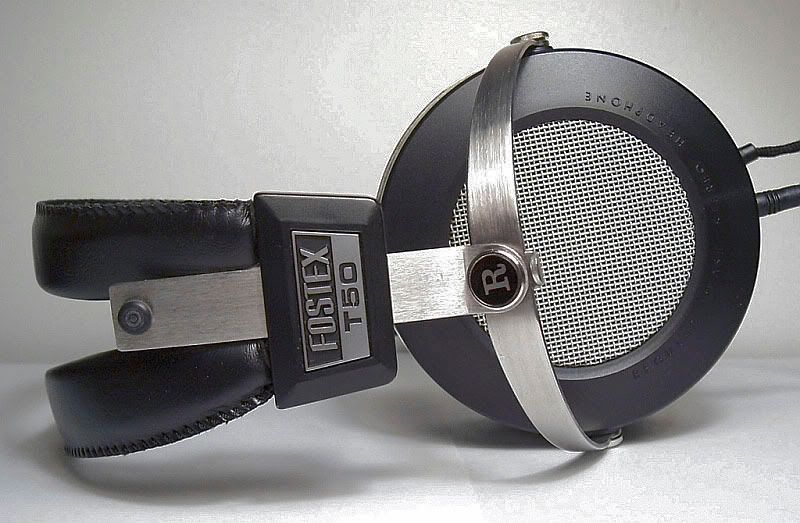
[size=xx-small]1978 FOSTEX T50[/size].................................................. ....................[size=xx-small]PHOTO BY TYRE[/size]
One of the more interesting planar-magnetic / isodynamic / orthodynamic 'phones from their heyday in the late '70s and '80s was (and still is) the original 1978 NA-market (introduced fall 1977) Fostex T50, not to be confused with the completely redesigned Fostex T50RP (pictured below), which hit the world market in 2002. I own a 2002 T50RP but have never been entirely happy with it and neither have other Head-Fi T50RP owners. Recently, though, I got lucky and snagged a T50 on eBay.
The T50 has earpieces that are about 4 inches in diameter and about 3/4 inch thick; this is a headphone that could easily be mistaken for an old-school electrostatic. The headband is nothing fancy, nowhere near as elaborate as the Yamaha/Bellini arch-and-strap, yet these heavy old 'phones are surprisingly comfortable. The huge leather earpads spread the weight very effectively; the sensation of wearing a pair of salad plates on one's head does eventually pass.
Unlike the old Yamaha Orthodynamics with their nontensioned ring-radiating corrugated diaphragm drivers, the T50 driver is basically a sandwich made up two round grilles of bar magnets clamping between them a smooth tensioned Kapton diaphragm with a printed-circuit voice coil on it; but where the voice coil imprinted on the Yamaha diaphragm is a spiral, the T50's vc is a serpentine pattern, looking something like an anaconda trying to form the letter M. Fostex claims better control over diaphragm motion with this arrangement.
Here's a peek inside. The driver assembly is 85mm in diameter, and the magnet structure is 62mm, the largest of any isodynamic so far [up to 2009, at any rate]. This is the side that faces the ear. Notice the felt mask that acts to equalize the path lengths to the ear from the various parts of the diaphragm. The design of this driver is more advanced than any Yamaha, including the YH-1000.
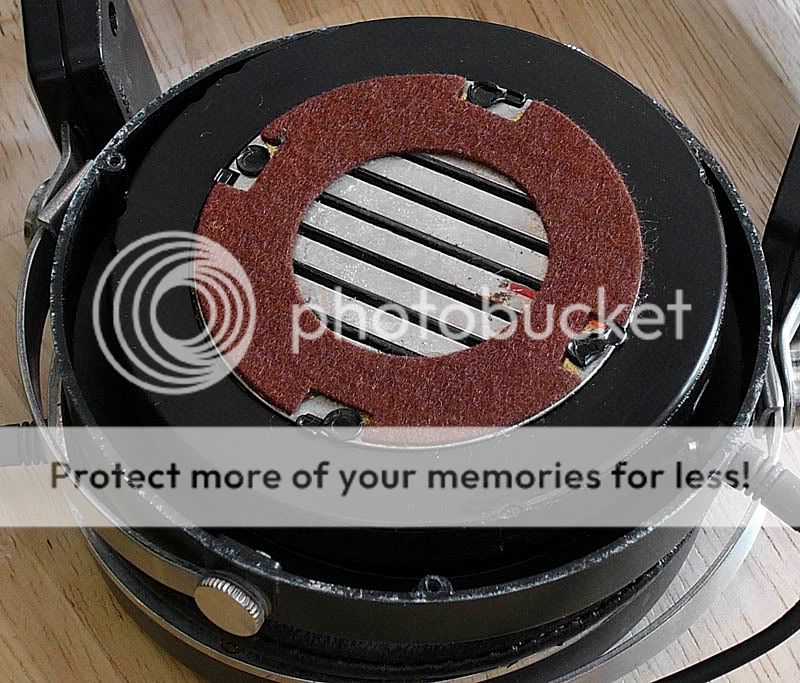
Again unlike most of the Yamahas, the T50 has open-back earcups. This remedies two nagging sonic defects caused by the Yamahas' closed-back cups: a treble "build-up" effect with associated roughness of the treble caused by internal reflections of the backwave, and a closed-in feeling caused by those same reflections. The T50 isn't as open as a Stax Lambda, but it's noticeably less closed than a Yamaha YH-100. Here's the back side of the T50 driver, covered with a double-layer mineral-wool damping/treble-absorbing "biscuit":
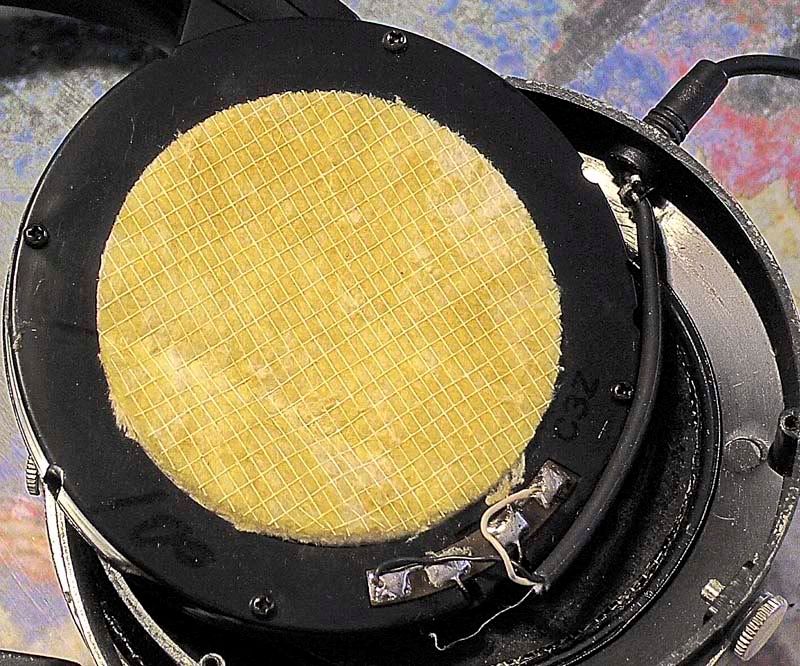
And here's what it looks like underneath that biscuit. You're looking at a steel plate with slots cut in it-- samarium-cobalt magnets are epoxied to the underside. You can see the printed-circuit voice coil through the yellow diaphragm. The diaphragm is yellow because it's made of Kapton, a polymer similar to Mylar but able to withstand much higher temperatures.

When you open up the driver, you're faced with bars of samarium cobalt and a beautiful aluminum voice coil printed on the Kapton.

[size=xx-small]ORIGINAL T50 DIAPHRAGM AND MAGNET STRUCTURE. PHOTO OF THE VISUALLY IDENTICAL MAIOR RPT-50 BY ERICJ[/size]
By today's standards both the Yamahas and the T50 are very low-sensitivity 'phones-- which doesn't stop them from playing very loud; you just have to have an amplifier with enough volt-amps to get them there.
Specifications for the T50, from the original Sept. 1977 brochure:
IMPEDANCE: 60 ohms
SENSITIVITY: 94dB/mW
MAX INPUT: 200mW
MAGNETS: anisotropic samarium-cobalt
DIAPHRAGM MATERIAL: polyimide (Kapton)
The old T50 and the new T50RP look and sound very different. The old one has bass and the new namesake has very little. What's inside?
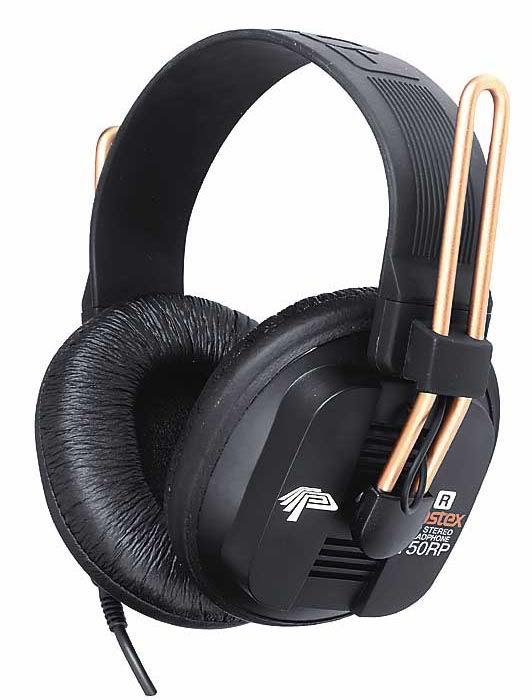
2002 Fostex T50RP
In contrast to the T50's huge magnet structure and big round diaphragm, inside the T50RP I found a tiny driver about 35mm square. No wonder these phones lack bass [UPDATE: it turns out-- you'll laugh-- it was largely the earpads' fault. Not that this is a bass monster with the ca. 2008 revised pads]. Any Fostex or Audio-Technica planar-type diaphragm has its max excursion only at its center; since its edges are constrained, it forms a dome at max excursion, and the area of this dome is much less than the diaphragm's total area. Max excursion in turn is limited by diaphragm tension. So it's not promising that the T50RP's diaphragm is small (as in the original T50, it's Kapton, to take the high power without melting), though that's not the whole story. The bass is actually there, thanks to the powerful neodymium magnets, but it takes a drastic amount of EQ to bring it up, as gerG shows in the link above. Below is a photo of my T50RP's driver. The white stuff is a damping film glued to the back of the driver, under tension.
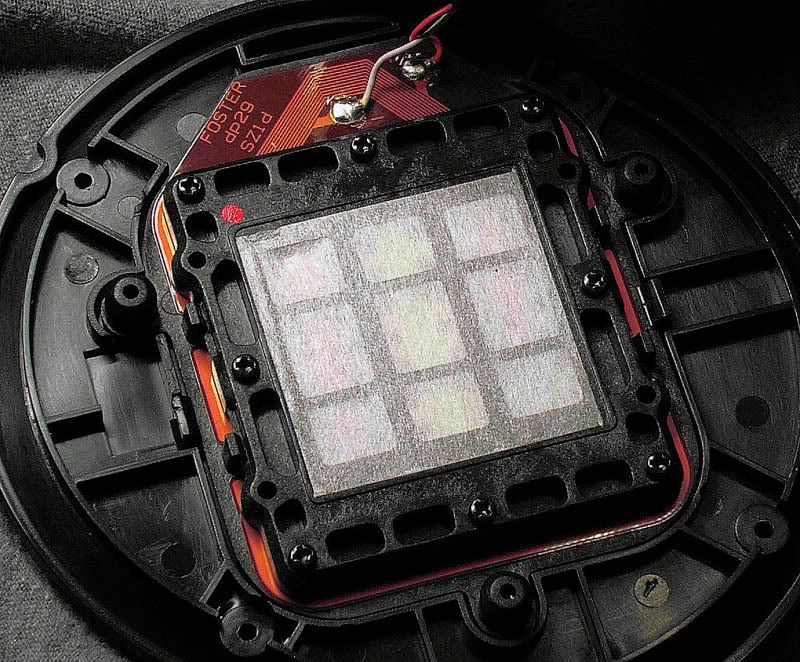
The T50RP, though it can be modified with good results (requiring strenuous effort), should be thought of primarily as a pro audio tool. It can swallow 3 watts of power, thereby generating enough clean SPL on a click track to make a drummer's ears bleed; it's lightweight enough to stay on an ADHD musician's head; it's cheap enough to throw away if the musician breaks it. That's what it was designed for.
In several ways the T50RP with its first-gen pads was the headphone sonic equivalent of a Peavey rock concert sound-reinforcement speaker, though the hallmark clarity of a planar-magnetic driver was (and still is) present.
...Imagine the frustration. With the gen-2 earpads, it's better, and can offer a taste of the planar-magnetic future, but, well... Turns out this hasn't stopped many people following member Smeggy's lead in trying to extract every last milligram of performance from this underachieving headphone.
The T50, on the other hand, was designed simply to sound as good as a headphone could while still being rugged enough for pro audio use. In the T50RP I had expected to find a super T50; what I got should've been given a completely different model number.
Reluctantly, then, we leave the bassless future represented by the 2004-era T50RP and turn back to the old T50:
I think the old T50 sounds very much like the Stax SR-X Mk 3 (which preceded it in the market by two to four years, depending on which market you mean), except that the Fostex has plenty of nice deep bass, but of course that's just one man's opinion. I'll merely suggest that if you tend to like the sound of planar speakers (Magneplanars, the Monsoon flat-panel computer speakers, &c.), you'll tend to like the sound of flat-driver headphones, and if you do, it'll be worth seeking out the old Fostex T50. It wasn't made in large quantities and was marketed as a pro audio item, so it won't be easy to find, but it will be worth the effort.
When this post was first written in late 2004, I wrote of the original T50: "If you find them on eBay, there's a chance you'll get them for a reasonable amount simply because not that many people know they exist." Sadly, this is no longer the case. The word is out, demand is high, and the supply has turned out to be vanishingly low.
* * * * * * * * *
Finally, to give the T50RP some credit, it's worth noting that, taking inflation into account, the old model would cost about four times what its "replacement" costs.
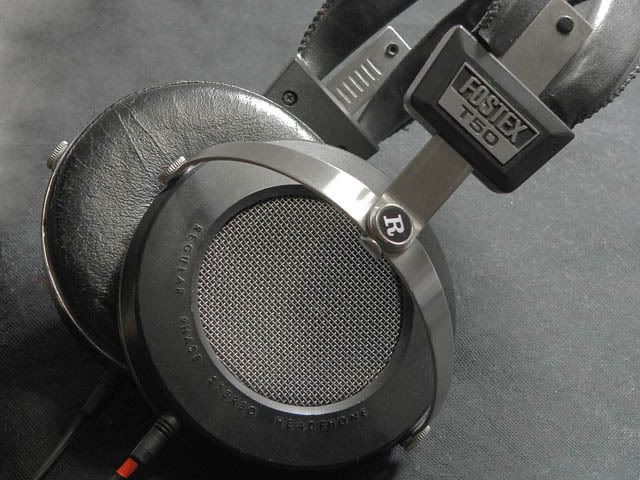
By the way, "RP" stands for Regular Phase, Fostex's in-house name for isodynamic. In other words, both the T50 and the T50RP are RP headphones. Confusing, no? In the '80s Fostex made RP tweeters (including a cute coax fullrange driver with an RP tweeter in the middle), RP midranges, complete RP/hybrid speaker systems , RP headphones, even a line of RP microphones, all under license from the UK company Strathearn, whose patents passed to the Rank Organisation. Sadly, of these only the headphones are still in production-- in fact, Fostex makes the only isodynamic headphones currently on the US market. Sadder still, none of them, past or present, has ever, without modification, sounded as good as the T50, not even close.
ADDENDA:
Thanks to Michael Gillespie of the Fostex forums (and original importer of Fostex headphones to North America), here's the cover of the original September 1977 Fostex brochure, showing the T50 in the foreground and the T20 behind it:
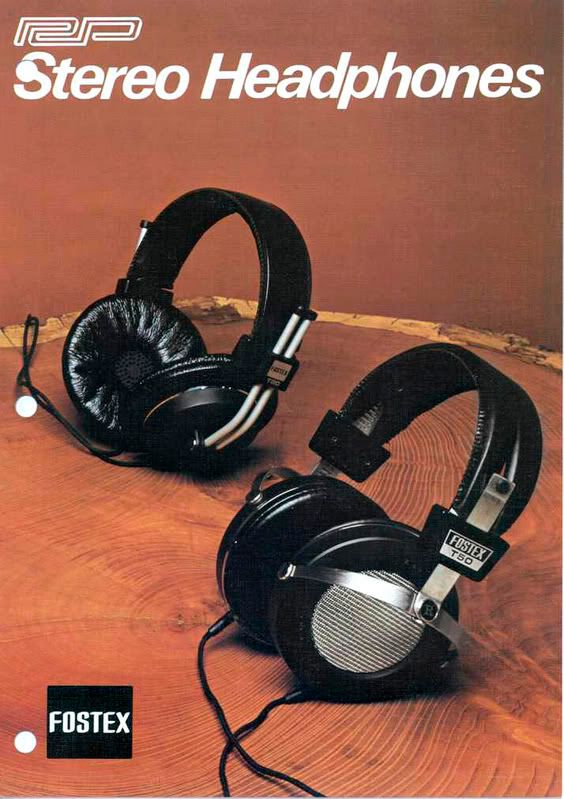
Interestingly, in the 1980 brochure Fostex changes the style of the T50's headband:
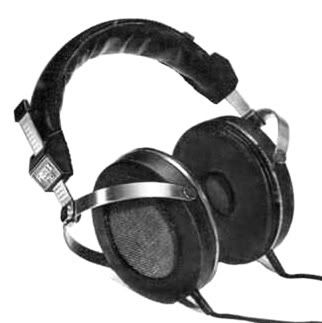
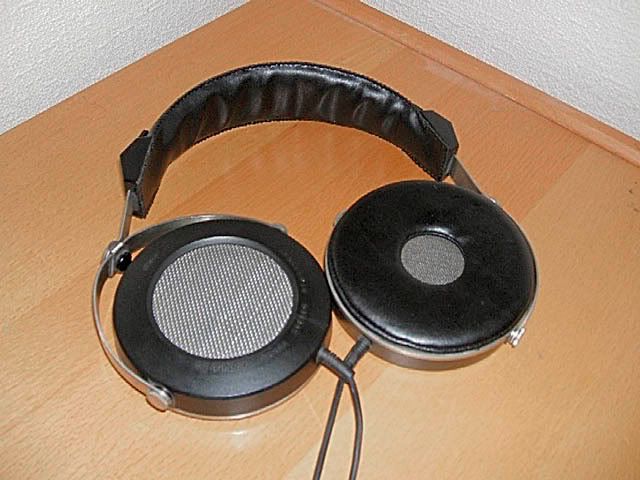
APPENDIX: Fostex made OEM "clone" versions of the T50 (NAD RP 18, pictured above right; also Maior RPT-50 and Lafayette RP-50) or variants of the T50 driver in OEM headphones (Sansui SS-100, Aiwa HP-500). The sound of the clone headphones, and the T50 itself, is most often not the same as the T50 I have. The bass and midrange are still there, but the response either rises to a high peak in the upper midrange, around 2kHz, and falls after that (Maior), or simply goes out flat and after about 1Khz starts to roll off (NAD), or some combination of the two. It turns out Fostex had been making T50 headphones with the single headband going back as early as 1975. They also changed the voice coil pattern slightly in post-1980 production, also single headband. Finally, there's some evidence that Fostex tweaked the sound of the T50 family to suit certain markets (NA, Germany). In fact, I am more and more of the opinion that the headphone I've been calling the T50v1 was a special model of a headphone Fostex had already been making and shopping all over the world (with uneven success) for ~3 years. It was, I believe, tweaked specially for the NA market, and there's some evidence that only the late production of this special run sounds like the T50 I have!
So the current recommendation is: There are many variations and variables. Try before you buy.
UPDATE: Fostex has changed the T50RP-- the new version has bass! We'll call these versions T50RPv1 and T50RPv2 to underline the fact that the T50RP is not a version of the original T50 but an entirely different headphone. The new version can be spotted only by looking for the flattened and shinier earpad. See post #33 in this thread.
.


[size=xx-small]1978 FOSTEX T50[/size].................................................. ....................[size=xx-small]PHOTO BY TYRE[/size]
One of the more interesting planar-magnetic / isodynamic / orthodynamic 'phones from their heyday in the late '70s and '80s was (and still is) the original 1978 NA-market (introduced fall 1977) Fostex T50, not to be confused with the completely redesigned Fostex T50RP (pictured below), which hit the world market in 2002. I own a 2002 T50RP but have never been entirely happy with it and neither have other Head-Fi T50RP owners. Recently, though, I got lucky and snagged a T50 on eBay.
The T50 has earpieces that are about 4 inches in diameter and about 3/4 inch thick; this is a headphone that could easily be mistaken for an old-school electrostatic. The headband is nothing fancy, nowhere near as elaborate as the Yamaha/Bellini arch-and-strap, yet these heavy old 'phones are surprisingly comfortable. The huge leather earpads spread the weight very effectively; the sensation of wearing a pair of salad plates on one's head does eventually pass.
Unlike the old Yamaha Orthodynamics with their nontensioned ring-radiating corrugated diaphragm drivers, the T50 driver is basically a sandwich made up two round grilles of bar magnets clamping between them a smooth tensioned Kapton diaphragm with a printed-circuit voice coil on it; but where the voice coil imprinted on the Yamaha diaphragm is a spiral, the T50's vc is a serpentine pattern, looking something like an anaconda trying to form the letter M. Fostex claims better control over diaphragm motion with this arrangement.
Here's a peek inside. The driver assembly is 85mm in diameter, and the magnet structure is 62mm, the largest of any isodynamic so far [up to 2009, at any rate]. This is the side that faces the ear. Notice the felt mask that acts to equalize the path lengths to the ear from the various parts of the diaphragm. The design of this driver is more advanced than any Yamaha, including the YH-1000.

Again unlike most of the Yamahas, the T50 has open-back earcups. This remedies two nagging sonic defects caused by the Yamahas' closed-back cups: a treble "build-up" effect with associated roughness of the treble caused by internal reflections of the backwave, and a closed-in feeling caused by those same reflections. The T50 isn't as open as a Stax Lambda, but it's noticeably less closed than a Yamaha YH-100. Here's the back side of the T50 driver, covered with a double-layer mineral-wool damping/treble-absorbing "biscuit":

And here's what it looks like underneath that biscuit. You're looking at a steel plate with slots cut in it-- samarium-cobalt magnets are epoxied to the underside. You can see the printed-circuit voice coil through the yellow diaphragm. The diaphragm is yellow because it's made of Kapton, a polymer similar to Mylar but able to withstand much higher temperatures.

When you open up the driver, you're faced with bars of samarium cobalt and a beautiful aluminum voice coil printed on the Kapton.

[size=xx-small]ORIGINAL T50 DIAPHRAGM AND MAGNET STRUCTURE. PHOTO OF THE VISUALLY IDENTICAL MAIOR RPT-50 BY ERICJ[/size]
By today's standards both the Yamahas and the T50 are very low-sensitivity 'phones-- which doesn't stop them from playing very loud; you just have to have an amplifier with enough volt-amps to get them there.
Specifications for the T50, from the original Sept. 1977 brochure:
IMPEDANCE: 60 ohms
SENSITIVITY: 94dB/mW
MAX INPUT: 200mW
MAGNETS: anisotropic samarium-cobalt
DIAPHRAGM MATERIAL: polyimide (Kapton)
The old T50 and the new T50RP look and sound very different. The old one has bass and the new namesake has very little. What's inside?

2002 Fostex T50RP
In contrast to the T50's huge magnet structure and big round diaphragm, inside the T50RP I found a tiny driver about 35mm square. No wonder these phones lack bass [UPDATE: it turns out-- you'll laugh-- it was largely the earpads' fault. Not that this is a bass monster with the ca. 2008 revised pads]. Any Fostex or Audio-Technica planar-type diaphragm has its max excursion only at its center; since its edges are constrained, it forms a dome at max excursion, and the area of this dome is much less than the diaphragm's total area. Max excursion in turn is limited by diaphragm tension. So it's not promising that the T50RP's diaphragm is small (as in the original T50, it's Kapton, to take the high power without melting), though that's not the whole story. The bass is actually there, thanks to the powerful neodymium magnets, but it takes a drastic amount of EQ to bring it up, as gerG shows in the link above. Below is a photo of my T50RP's driver. The white stuff is a damping film glued to the back of the driver, under tension.

The T50RP, though it can be modified with good results (requiring strenuous effort), should be thought of primarily as a pro audio tool. It can swallow 3 watts of power, thereby generating enough clean SPL on a click track to make a drummer's ears bleed; it's lightweight enough to stay on an ADHD musician's head; it's cheap enough to throw away if the musician breaks it. That's what it was designed for.
In several ways the T50RP with its first-gen pads was the headphone sonic equivalent of a Peavey rock concert sound-reinforcement speaker, though the hallmark clarity of a planar-magnetic driver was (and still is) present.
...Imagine the frustration. With the gen-2 earpads, it's better, and can offer a taste of the planar-magnetic future, but, well... Turns out this hasn't stopped many people following member Smeggy's lead in trying to extract every last milligram of performance from this underachieving headphone.
The T50, on the other hand, was designed simply to sound as good as a headphone could while still being rugged enough for pro audio use. In the T50RP I had expected to find a super T50; what I got should've been given a completely different model number.
Reluctantly, then, we leave the bassless future represented by the 2004-era T50RP and turn back to the old T50:
I think the old T50 sounds very much like the Stax SR-X Mk 3 (which preceded it in the market by two to four years, depending on which market you mean), except that the Fostex has plenty of nice deep bass, but of course that's just one man's opinion. I'll merely suggest that if you tend to like the sound of planar speakers (Magneplanars, the Monsoon flat-panel computer speakers, &c.), you'll tend to like the sound of flat-driver headphones, and if you do, it'll be worth seeking out the old Fostex T50. It wasn't made in large quantities and was marketed as a pro audio item, so it won't be easy to find, but it will be worth the effort.
When this post was first written in late 2004, I wrote of the original T50: "If you find them on eBay, there's a chance you'll get them for a reasonable amount simply because not that many people know they exist." Sadly, this is no longer the case. The word is out, demand is high, and the supply has turned out to be vanishingly low.
* * * * * * * * *
Finally, to give the T50RP some credit, it's worth noting that, taking inflation into account, the old model would cost about four times what its "replacement" costs.

By the way, "RP" stands for Regular Phase, Fostex's in-house name for isodynamic. In other words, both the T50 and the T50RP are RP headphones. Confusing, no? In the '80s Fostex made RP tweeters (including a cute coax fullrange driver with an RP tweeter in the middle), RP midranges, complete RP/hybrid speaker systems , RP headphones, even a line of RP microphones, all under license from the UK company Strathearn, whose patents passed to the Rank Organisation. Sadly, of these only the headphones are still in production-- in fact, Fostex makes the only isodynamic headphones currently on the US market. Sadder still, none of them, past or present, has ever, without modification, sounded as good as the T50, not even close.
ADDENDA:
Thanks to Michael Gillespie of the Fostex forums (and original importer of Fostex headphones to North America), here's the cover of the original September 1977 Fostex brochure, showing the T50 in the foreground and the T20 behind it:

Interestingly, in the 1980 brochure Fostex changes the style of the T50's headband:


APPENDIX: Fostex made OEM "clone" versions of the T50 (NAD RP 18, pictured above right; also Maior RPT-50 and Lafayette RP-50) or variants of the T50 driver in OEM headphones (Sansui SS-100, Aiwa HP-500). The sound of the clone headphones, and the T50 itself, is most often not the same as the T50 I have. The bass and midrange are still there, but the response either rises to a high peak in the upper midrange, around 2kHz, and falls after that (Maior), or simply goes out flat and after about 1Khz starts to roll off (NAD), or some combination of the two. It turns out Fostex had been making T50 headphones with the single headband going back as early as 1975. They also changed the voice coil pattern slightly in post-1980 production, also single headband. Finally, there's some evidence that Fostex tweaked the sound of the T50 family to suit certain markets (NA, Germany). In fact, I am more and more of the opinion that the headphone I've been calling the T50v1 was a special model of a headphone Fostex had already been making and shopping all over the world (with uneven success) for ~3 years. It was, I believe, tweaked specially for the NA market, and there's some evidence that only the late production of this special run sounds like the T50 I have!
So the current recommendation is: There are many variations and variables. Try before you buy.
UPDATE: Fostex has changed the T50RP-- the new version has bass! We'll call these versions T50RPv1 and T50RPv2 to underline the fact that the T50RP is not a version of the original T50 but an entirely different headphone. The new version can be spotted only by looking for the flattened and shinier earpad. See post #33 in this thread.
.












